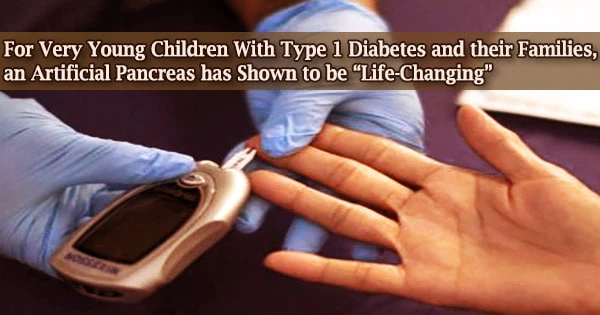Insulin-dependent diabetes, or juvenile diabetes, was originally a term used to describe type 1 diabetes. It most commonly affects children, teenagers, and young adults, but it can affect anyone at any age. Type 1 diabetes is less frequent than type 2 diabetes; roughly 5-10% of diabetics have type 1.
A Cambridge-developed artificial pancreas is helping to safeguard very young children with type 1 diabetes at a very vulnerable point in their lives. According to a study published today (January 20, 2022), it is both safe and effective at controlling blood sugar levels than current technologies.
Researchers compared the performance of the artificial pancreas, which employs an algorithm to estimate the quantity of insulin supplied via a device worn by the child, to ‘sensor-augmented pump therapy’ in the New England Journal of Medicine.
Because of a variety of factors, such as the significant variability in insulin levels required and how individual children respond to treatment, and their unpredictable feeding and activity patterns, managing type 1 diabetes in very young children is difficult.
An autoimmune reaction is assumed to be the etiology of type 1 diabetes (the body attacks itself by mistake). The beta cells in the pancreas, which produce insulin, are destroyed by this process. Before any symptoms develop, this process might carry on for months or even years.
Children are especially vulnerable to dangerously low blood sugar levels (hypoglycemia) and dangerously high blood sugar levels (hyperglycemia). Prolonged hyperglycemia has been linked to lower IQ scores and slower brain maturation in children with type 1 diabetes in previous research. Certain genes (characteristics passed down from parents to children) make some people more prone to acquire type 1 diabetes.
Doctors are increasingly turning to devices that continually monitor glucose levels and provide insulin via a pump, which distributes insulin through a cannula implanted into the skin, to regulate children’s glucose levels. These gadgets have been successful in older children to some extent, but not in very young children.
Parents must use a monitor to check their child’s glucose levels and then manually regulate the amount of insulin supplied by the pump utilizing current technology sensor-augmented pump therapy.
Professor Roman Hovorka of the University of Cambridge’s Wellcome-MRC Institute of Metabolic Science has developed the CamAPS FX app, which, when used in conjunction with a glucose monitor and insulin pump, acts as an artificial pancreas, automatically adjusting the amount of insulin delivered based on predicted or real-time glucose levels.
Very young children are extremely vulnerable to changes in their blood sugar levels. High levels in particular can have potentially lasting consequences to their brain development. On top of that, diabetes is very challenging to manage in this age group, creating a huge burden for families. CamAPS FX led to improvements in several measures, including hyperglycaemia and average blood sugar levels, without increasing the risk of hypos. This is likely to have important benefits for those children who use it.
Dr. Julia Ware
It’s a ‘hybrid closed-loop system,’ which means the child’s caregiver will have to deliver insulin at mealtimes, but the algorithm will run on its own the rest of the time. There are currently no commercially available totally closed-loop systems.
Professor Hovorka explained: “CamAPS FX makes predictions about what it thinks is likely to happen next based on past experience. It learns how much insulin the child needs per day and how this changes at different times of the day. It then uses this to adjust insulin levels to help achieve ideal blood sugar levels. Other than at mealtimes, it is fully automated, so parents do not need to continually monitor their child’s blood sugar levels.”
Professor Hovorka and an international team of researchers recruited 74 children with type 1 diabetes, aged one to seven years, to take part in their trial across seven centers in the UK and Europe.
The trial compared the safety and efficacy of sensor-augmented pump therapy to hybrid closed-loop therapy. For 16 weeks, all of the children used the CamAPS FX hybrid closed-loop system, followed by 16 weeks of the control treatment (sensor-augmented pump therapy).
When using CamAPS FX, children spent nearly three-quarters of their day (71.6%) in the goal range for their glucose levels, which was about nine percentage points higher than the control period and amounted to an additional 125 minutes per day in the target range.
While using CamAPS FX, the youngsters spent less than a quarter (22.9%) of their time with elevated blood sugar levels (hyperglycemia), nearly nine percentage points less than during the control period. In terms of time spent in hypoglycemia, there was no difference between the two groups.
The app reduced average blood sugar levels, which is measured by a molecule called HbA1c (glycated haemoglobin). When haemoglobin, a protein found in red blood cells that transports oxygen throughout the body, binds with glucose in the blood, it becomes glycated.
Clinicians can obtain an overall picture of a person’s average blood sugar levels over a period of weeks or months by monitoring HbA1c. The higher the HbA1c in people with diabetes, the greater the chance of acquiring diabetes-related problems.
HbA1c readings were 7.3 percent at the start, but the app lowered them by 0.7 percentage points. This is especially notable because the study participants had strong glycaemic control to begin with, i.e., a low HbA1c, and it’s frequently difficult to increase glucose control without having additional low blood glucose events (hypoglycaemia).
Dr. Julia Ware, the study’s first author, also from the Wellcome-MRC Institute of Metabolic Science, said: “Very young children are extremely vulnerable to changes in their blood sugar levels. High levels in particular can have potentially lasting consequences to their brain development. On top of that, diabetes is very challenging to manage in this age group, creating a huge burden for families.”
“CamAPS FX led to improvements in several measures, including hyperglycaemia and average blood sugar levels, without increasing the risk of hypos. This is likely to have important benefits for those children who use it.”
Poor sleep quality is one of the most common complaints among families with young children with type 1 diabetes, as insulin requirements and parental concern of hypoglycemia are most variable overnight.
The researchers discovered that more than 80% of overnight sensor readings were within the target range, demonstrating that hybrid closed-loop therapy is more effective than sensor-augmented pump therapy in addressing the ‘night-time problem.’
Dr. Ware added: “Parents have described our artificial pancreas as ‘life-changing’ as it meant they were able to relax and spend less time worrying about their child’s blood sugar levels, particularly at night time. They tell us it gives them more time to do what any ‘normal’ family can do, to play and do fun things with their children.”
CamAPS FX is already making a difference in children’s and their families’ lives. It is already available through a number of NHS trusts in the United Kingdom, including Cambridge University Hospitals NHS Foundation Trust, and the team hopes to expand its availability soon.
Professor Hovorka added: “From the first clinical trials of our algorithms to today’s findings has taken well over a decade, but the dedication of my team and the support of all the children and families who have taken part in our studies, has paid off. We believe our artificial pancreas will transform the lives of families with very young children affected by type 1 diabetes.”
CamAPS FX has been demonstrated to be effective in type 1 diabetes in older children and adolescents. This is the first time it has been proved to be helpful in very young children over a period of months. The study was supported by the European Commission’s Horizon 2020 Framework Programme, as well as the NIHR Cambridge Biomedical Research Centre and the JDRF. CamAPS FX has been commercialized by CamDiab, Professor Hovorka’s spin-out company.
















